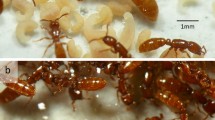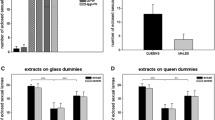Abstract
The occurrence of a pre-imaginal caste determination represents a sort of “point of no return” to eusociality. In some social insect taxa, including Polistes species, the occurrence of distinct queen and worker castes is still debated. Before this report, no clear morphological differences between reproductive and non-reproductive individuals were known. Here we show that several pre-imaginal morphological differences of the Van der Vecht organ occur between foundresses (queens) and workers. Geometric morphometrics revealed that queens are characterized by shape deformations of this organ, which is responsible for a typical allometric growth of the secretory area. This organ is predicted to be larger in foundresses compared to workers because its secretion is involved in defense against ants, in nestmate recognition and in preventing workers from challenging for direct reproduction. The results presented here indicate the existence of an incipient morphological caste determination Polistes gallicus and suggest that this species may have passed the “point of no return” for eusociality.



Similar content being viewed by others
References
Adams DC, Funk DJ (1997) Morphometric inferences on sibling species and sexual dimorphism in Neochlamisus bebbianae leaf beetles: multivariate applications of the thin-plate spline. Syst Biol 46:180–194
Batra SWT (1966) Nests and social behavior of halictine bees of India. Indian J Entomol 28:375–393
Bookstein FL (1997) Landmark methods for forms without landmarks: localizing group differences in outline shape. Med Image Anal 1:225–243
Boomsma JJ (2007) Kin selection versus sexual selection: why the ends do not meet. Curr Biol 17:R673–R683. doi:10.1016/j.cub.2007.06.033
Cervo R, Turillazzi S (1989) Nest exchange experiments in Polistes gallicus (L.). Ethol Ecol Evol 1:185–193
Dani FR (1994) Caste size differences in Polistes gallicus (L.) (Hymenoptera Vespidae). Ethol Ecol Evol (Special Issue) 3:67–73
Dani F, Cervo R, Turillazzi S (1992) Abdomen stroking behaviour and its possible functions in Polistes dominulus (Christ) (Hymenoptera, Vespidae). Behav Process 28:51–58
Dani FR, Jones GR, Morgan DE, Turillazzi S (2003) Reevaluation of the chemical secretion of the sternal glands of Polistes social wasps (Hymenoptera Vespidae). Ethol Ecol Evol 15:73–82
Dapporto L, Sledge MF, Turillazzi S (2005) Dynamics of cuticular chemical profiles of Polistes dominulus workers in orphaned nests. J Insect Physiol 51:969–973
Dapporto L, Santini A, Dani FR, Turillazzi S (2007) Workers of a Polistes paper wasp detect the presence of their queen by chemical cues. Chem Senses 32:795–802
Darwin C (1859) On the origin of species by means of natural selection, or the preservation of favoured races in the struggle for life, 1st edn. John Murray, London
Eickwort K (1969) Separation of the castes of Polistes exclamans and notes on its biology (Hym:Vespidae). Insectes Soc 16:67–72
Gamboa GJ (2004) Kin recognition in eusocial wasps. Ann Zool Fennici 41:789–808
Hunt JH, Amdam GV (2005) Bivoltinism as an antecedent to eusociality in the paper wasp genus Polistes. Science 308:264–267
Hunt JH, Buck NA, Wheeler DE (2003) Storage proteins in vespid wasps: characterization, developmental pattern, and occurrence in adults. J Insect Physiol 49:785–794
Hunt JH, Kensinger BA, Kossuth J, Henshaw MT, Norberg K, Wolschin F, Amdam GV (2007) From casteless to castes–a diapause pathway underlies the gyne phenotype in Polistes paper wasps. Proc Natl Acad Sci USA 104:14020–14025
Hunt JH, Wolschin F, Henshaw MT, Newman TC, Toth AL, Amdam GV (2010) Differential gene expression and protein abundance evince ontogenetic bias toward castes in a primitively eusocial wasp. PLoS One 17:e10674
Liebig J (2010) Hydrocarbon profiles indicate fertility and dominance status in ant, bee, and wasp colonies. In: Blomquist GJ, Bagnères AG (eds) Insect hydrocarbons: biology, biochemistry, chemical ecology. Cambridge University Press, Cambridge, pp 254–281
London KB, Jeanne RL (2000) The interaction between mode of colony founding, nest architecture and ant defense in polistine wasps. Ethol Ecol Evol 12:13–25
Reeve HK (1991) Polistes. In: Ross KG, Matthews RW (eds) The social biology of wasps. Comstock, Ithaca, pp 99–148
Reeve HK, Peters JM, Nonacs P, Starks PT (1998) Dispersal of first “workers” in social wasps: causes and implications of an alternative reproductive strategy. Proc Natl Acad Sci USA 95:13737–13742
Rohlf FJ (2009) TpsRegr, version 1.37. Department of Ecology and Evolution, State University of New York at Stony Brook
Rohlf FJ (2010) TpsDig, digitize landmarks and outlines, version 2.16. Department of Ecology and Evolution, State University of New York at Stony Brook
Solís CR, Strassmann JE (1990) Presence of brood affects caste differentiation in the social wasp, Polistes exclamans Vierek (Hymenoptera: Vespidae). Funct Ecol 4:531–541
Starks ST, Turillazzi S (Eds) (2006) Polistes paper wasps: emergence of a model genus. Ann Zool Fennici 43
Strassmann JE (1981) Evolutionary implications of early male and satellite nest production in Polistes exclamans colony cycles. Behav Ecol Sociobiol 8:55–64
Strassmann JE (1985) Worker mortality and the evolution of castes in the social wasp Polistes exclamans. Insectes Soc 32:275–285
Strassmann JE, Hughes CR, Queller DC, Turillazzi S, Cervo R, Davis SK, Goodnight KF (1989) Genetic relatedness in primitively eusocial wasps. Nature 342:268–270
Toth AL, Bilof KBJ, Henshaw MT, Hunt JH, Robinson GE (2009) Lipid stores, ovary development, and brain gene expression in Polistes metricus females. Insect Soc 56:77–84. doi:10.1007/s00040-008-1041-2
Turillazzi S (1979) Tegumental glands in the abdomen of some European Polistes (Hymenoptera Vespidae). Monit Zool Ital (NS) 13:67–70
Van Hooser CA, Gamboa GJ, Fishwild TG (2002) The function of abdominal stroking in the paper wasp, Polistes fuscatus (Hymenoptera Vespidae). Ethol Ecol Evol 14:141–148
Wilson EO (1971) The insect societies. Belknap Press of Harvard University Press, Cambridge
Wilson EO, Hölldobler B (2005) Eusociality: origin and consequences. Proc Natl Acad Sci USA 102:13367–13371
Acknowledgments
Research performed with funds from the University of Firenze (60% Dept of Evolutionary Biology and Centro di Servizi per la Spettrometria di Massa (CISM) of the University of Firenze). We thank Thomas Bartolomaeus, Andrea Cardini and two anonymous referees for improving an early version of the manuscript and Prof. Roscoe Stanyon of the University of Firenze for the revision of the English text.
Author information
Authors and Affiliations
Corresponding author
Additional information
Communicated by T. Bartolomaeus.
Rights and permissions
About this article
Cite this article
Dapporto, L., Petrocelli, I. & Turillazzi, S. Incipient morphological castes in Polistes gallicus (Vespidae, Hymenoptera). Zoomorphology 130, 197–201 (2011). https://doi.org/10.1007/s00435-011-0130-3
Received:
Revised:
Accepted:
Published:
Issue Date:
DOI: https://doi.org/10.1007/s00435-011-0130-3




